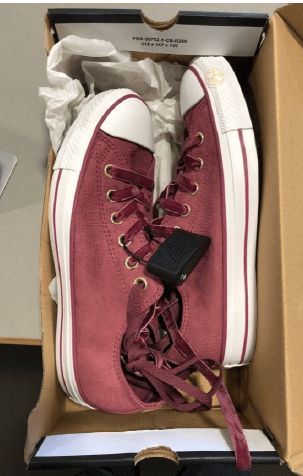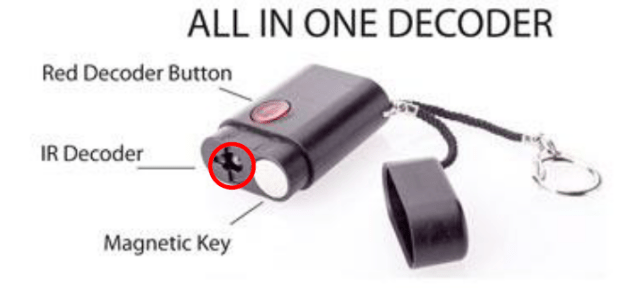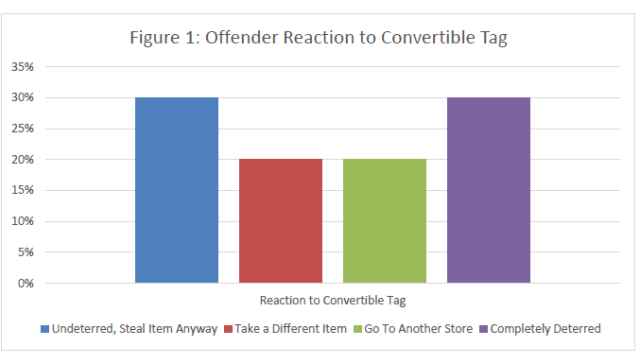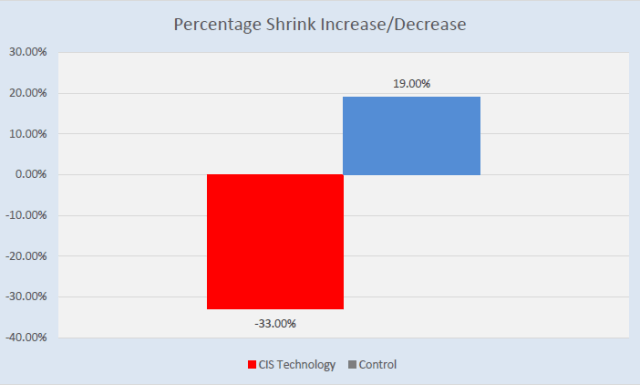LPRC Research Report CIS Convertible Tether

CIS Convertible IR/Magnet Tag and Gen5 Tether.
Shrink Analysis, Offender, Customer, and Associate Feedback
Michael B. Giblin, Dr.Read Hayes
Executive Summary
Introduction
The Loss Prevention Research Council (LPRC) conducted a series of in-person survey interviews at a Jacksonville, FL Mid-box StoreLab and Miami, FL Mid-box StoreLab in order to understand associate, customer, and offender reactions to CIS’s IR/Magnet Convertible tag and detacher, as well as Gen-5 Tethers. An LPRC Research Scientist designed all data collection tools and collected data in September and November 2018. The trial portion of this test, along with another set of Customer, Offender, and Associate data and an additional technological focus of anti-shoplifting tethers, will be collected and released as an updated report as soon as available.
Research Goals
Customers
- Do customers notice (See It) the CIS Convertible Tag/Tether?
- Are customers bothered by the presence of the CIS Convertible Tag/Tether?
- Do customers believe the CIS Convertible Tag/Tether will be an effective crime deterrent?
Offenders
- Do active offenders notice (See It) the CIS Convertible Tag/Tether?
- Do offenders understand the purpose (Get It) of the CIS Convertible Tag/Tether as well as perceive it to be a credible threat (Fear It)?
- Does the CIS Convertible Tag/Tether influence potential shoplifting behavior in offenders?
Associates
- How are associates daily duties affected by CIS Convertible Tag/Tether?
- How do associates feel the CIS Convertible Tag/Tether compares to the previous technology in use in terms of deterrence and customer perception?
- Do associates believe the CIS Convertible Tag/Tether is an effective crime deterrent?
Background:
EAS technologies are important deterrents, providing several key benefits in a retail setting. However, they are limited in their effectiveness against offenders who are willing and able to obtain detaching devices, particularly those involved in ORC. Several of LPRC’s Retail members have expressed concerns about the accessibility of various EAS technologies’ respective detachers. LPRC has conducted a comprehensive report on this issue, available to members as a 2018 report release.
This report outlines the reactions to the CIS IR/magnet and Tether interventions from 3 populations of interest: Active Offenders, Customers, and Associates. Combining these technologies as a dual-function release seeks to provide a key benefit: denying would-be shoplifters the ability to detach tags using standard magnets. In fact, the technology is designed in such a way that an unwitting offender who brings a magnet with them will be met with a loud alarm from the Convertible tag. This research was conducted on shoes in an upscale outdoor mall in Jacksonville, FL, shoes in Miami, FL, and high end hand bags in Miami, FL.
Images 1 and 2: Previously Deployed Technology (Left) and CIS Convertible Tag (Right)


Image 3: CIS Convertible Tag in Test Setting (IR sensor circled in red)

Image 4: CIS IR/Magnet Detacher Technology

Image 5: CIS Gen-5 Tether in Test Settingy

Full Research Results: Convertible Tag
Customers (n=15)
Customers were intercepted by an LPRC Research Scientist and asked if they’d be willing to answer a few questions related to Loss Prevention. Those that agreed were presented with a pair of Vans shoes that had a CIS Convertible Tag attached to the lace eyelet.
Below are direct Customer quotes regarding the CIS Convertible Tag:
- “Lock (on other tags) makes me feel like I’m being accused”
- “As long as they’re not in the way of trying them on I don’t care. Prefer smaller I guess”
- “These are nice”
- “Looks more secure (than other tags)”
- “This is less bulky (than other tags)”
- “This looks more intimidating, or odd I guess”
- “I’m from Costa Rica, this is nothing”
- “I prefer these tags to others I’ve seen because they are more comfortable to try on (the shoes)”
Associates (n=11)
Two of the Associates interviewed were warehouse and stockroom associates, while 5 were sales associates, two were assistant store manager, and two were store manager. Their tenure ranged from 1 month to 166 months, with an average tenure of 28 months and a median tenure of 18 months.
Associates rated their experience with the CIS Convertible tags at 3.9 out of 7, indicating a neutral overall attitude, which was slightly lower than the 4.2 rating received by the previous tag technology. Associates frequently cited false alarms as the main source of concern in both stores, explaining that while the loop version of the solution works well, the pin solution was currently being reworked due to pin-length issues. Associates generally indicated that they would prefer the CIS solution to the old tags once that issue was resolved, as they liked the increased deterrent benefit of the CIS tags.
UPDATE: Since this report, the pin lengths have been changed to accommodate the different thicknesses of the shoes, and the face of the convertible has been remolded to match the exclusive handheld decoder, increasing ease of use/ease of removal of Convertible Tags, and a substantial reduction of false alarms.
Direct Associate quotes on Convertible tag below:
- “Louder and more sensitive”
- “New one is loud and super sensitive. Can be a hassle”
- “We hear cis go off all the time. The old ones don’t typically just go off, being sensitive has its pros and cons. Cis is easy going on, off was a learning curve”
- “New ones are going off too often. Pins too difficult to detach”
- “The new ones are too sensitive, when we move them they alarm”
- “The old ones only half would alarm I guess when you clipped them. And we had people coming in with magnets and taking them right off. With these new ones you can’t do that. We actually had a habitual offender come in and get caught up trying, it was great. She tried detaching it with a magnet and it started screaming on her. She didn’t know what to do”
- “Tags make noise, have to go to the front and take them off”
- “Others are easier and faster and don’t beep a lot”
- “Good at preventing theft, but a little sensitive to false alarms”
- “Tag comes off and false alarms. 3 on Black Friday”
Regarding customer perceptions, associates rated the old protection method as neutral (4.0 in Jacksonville and 4.2 in Miami out of 7) and the Convertible tag as 3.5 in Jacksonville and 3.0 in Miami out of 7, citing that the false alarms were somewhat disruptive to customers.
Importantly, while these previous differences have been somewhat modest, when it comes to offender deterrence associates rated the Convertible tag at 5.4 (Miami) and 6.2 (Jacksonville) out of 7 (“Very Deterred”), while rating the previous tag at 3.6 (Miami) and 3.3 (Jacksonville) out of 7. Overall sentiment was that the Convertible tag was a much better shoplifting deterrent, with a current pin issue that once resolved would make it equal to the older tags in the other categories.
Associate quotes on Convertible tag Deterrence below:
- “The fact that they scream loud. As soon as you hear the scream, you know someone’s at the vans”
- “This will definitely scare them. Because it’s new. The shape is scarier. Blinking light is more obvious”
- “When we’re selling these vans we know it’s protected”
- “I like the tags. Loud enough to hear across the store”
- “Screams when they test it with their magnet. Offenders taken aback by new tag. Causing them a lot more work that they won’t want to deal with”
Given the choice between the 2 technologies in their current states, 36% of associates selected the Convertible tag, while 27% selected the older tag technology and 36% had no preference.
Offenders (n=10)
Similar to the customers intercepted, offenders were presented with a pair of shoes similar to Image 2 with the Convertible tag on it and asked if they noticed any deterrents on the product. 100% of offenders noticed (See It) the tag, and 1 offender indicated that he’d seen the Convertible tag before at another retail chain that does happen to use the Convertible tag.
While 100% identified the tag as a deterrent (Get It) , 80% of offenders also understood the mechanism of the tag, correctly guessing that the tag had a built in alarm and would set off the EAS pedestals. The remaining 20% did not guess that the tag had a built-in alarm.
In response to the Convertible tag, offenders rated their likelihood of attempting to steal an item protected by the Convertible tag at 3.4 out of 7 in Jacksonville, and 2.0 out of 7 in Miami, for a total average deterrence of 2.7 out of 7, or well below “somewhat likely”. A breakdown of reactions to the tag below in figure 1

Direct Offender Feedback/Suggestions
Below are direct quotes of interest from the 5 offenders that participated in this test, adding further qualitative context to the quantitative data that was collected and analyzed here.
- “That’s pretty brilliant. That’s a brilliant idea. I wouldn’t touch it”
- “Bulky technology like this screams ‘don’t steal me, I’m way overprotected’”
- “A friend of mine has found a way to defeat the loop, but not the pin”
- “Put it on both shoes”
- “Bail costs more than the shoes are worth”
- “Most cell phones have IR burst, I’d find a way to use that”
- “I wouldn’t try to remove it, I’d put it in a bag (booster). Aluminum around pant leg? With jeans on?”
- “I’d cut the shoe, a little damage doesn’t matter”
- “I’d avoid it altogether”
- “I’m not f&#*ing with anything in this store once I see this. This is crazy”
- “Great that the IR stops normal magnets from working. It will alarm before I realize it needs IR and I’ll be stuck”
- “Great that the IR stops normal magnets from working. It will alarm before I realize it needs IR and I’ll be stuck”
- “Easier to steal shoes at other stores like foot locker”
- “No (other) shoe stores have these. (This store) is stepping up, noticeable.”
- “Can’t do nothin unless you’re a one footed thief”
Full Research Results: Gen-5 Tether
Customers (n=15)
Customers were intercepted by an LPRC Research Scientist and asked if they’d be willing to answer a few questions related to Loss Prevention. Those that agreed were presented with a Michael Kors handbag that had a CIS Gen-5 Tether attaching it to the fixture.
60% of Customers indicated that they had never noticed the Gen-5 Tether or any technology like it while shopping in this store (See It) . Customers expressed a slight preference for the Gen-5 Tether to other tethers they’d seen in the store, rating an average of 4.1 where 4.0 was “no preference” and 7 was “strongly prefer CIS Tether”. The presence of the Gen-5 Tether had no effect on customer’s feeling comfortable shopping at this store, indicated by a 4.0 average rating where 4.0 was “no difference in comfort”. Customers believed the Gen-5 Tether would be an effective deterrent, rating it an average of 5.0 where 7 was “Very Effective at Preventing Shoplifting”. The presence of the technology did not affect customer’s intentions to continue to shop at the store.
Associates (n=5)
Three of the Associates interviewed were sales associates, while one was an assistant store manager, and one was the store manager. Their tenure ranged from 1 month to 72 months, with an average tenure of 23 months.
Associates rated their experience with the CIS Gen-5 Tether at 4.8 out of 7, indicating a neutral overall attitude, which was significantly warmer than the 3.6 rating received by the previous tether technology. Associates frequently cited durability and a clean, serious look as positives.
Direct Associate quotes on CIS Gen-5 Tether below:
- “Tether: Clean look. Easy to shop with. Easy to use. More durable. Don’t get tangled and bent up.”
- “These are great!”
Regarding customer perceptions, associates rated the old protection method as near neutral (3.8 out of 7) and the Gen-5 Tether as 4.6 out of 7. When it comes to offender deterrence associates rated the Gen-5 Tether at 5.2 out of 7 (“Very Deterred”), while rating the previous tag at 3.8 out of 7.
Given the choice between the 2 technologies in their current states, 80% of associates selected the Gen-5 Tether, while 0% selected the older tether technology and 20% had no preference.
Offenders (n=5)
Offenders were presented with a high end hand bag and asked if they noticed any deterrents on the product. 100% of offenders noticed (See It) the Gen-5 Tether. While 100% identified the tag as a deterrent (Get It) , 80% of offenders also understood the mechanism of the tether, correctly guessing that the tag had a built in alarm that would go off when any part of the tether was cut or the entire tether was removed. 1 offender did not believe that the tether would alarm, and instead thought that people around him would hear the snip noise from his wire cutters, leading to deterrence.
In response to the Gen-5 Tether, offenders rated their likelihood of attempting to steal an item protected by the tether at 1 out of 7, “Extremely unlikely”. Not a single offender was at all willing to attempt theft of an item protected by this solution. A breakdown of reactions to the tether below in figure 1 (Fear It)

Direct Offender Feedback/Suggestions
Below are direct quotes of interest from the 5 offenders that participated in this test, adding further qualitative context to the quantitative data that was collected and analyzed here.
- “I’d go to a different store and I’ll tell you why, this store looks like they’ve got their s&%# together because of this. This is way better.”
- “Too complicated and too much time, wouldn’t even touch it or bother”
- “I like the size. It’s pretty cool. It’s actually scary to us habitual shoplifters. Too much f&#*ing work. You’ll get caught.”
- “Looks like a weight sensor. (Confused by some not being attached to anything. Made function unclear)”
- “Reminds me of the phone tethers”
- “It alarms if I pull it too far, right? (thinks it starts the alarm like a pull-start lawn mower, incorrect understanding of function)”
- “Never seen before. Don’t know if alarm would go off. Would leave alone”
- “Obviously if you try to cut it it’s gonna go off. This is crazy, I’ve never seen anything like it before. More threatening than what I usually see. You’d have a hard time”
- “You’ll hear the wire cutter click (doesn’t think it alarms).”
Shrink Results
Please note that these analyses and results were provided by the participating retailer. The LPRC did not have access to the data from which these results were determined.
Pre-test period and Test-period shrink were measured for the two categories of interest, shoes and high end hand bags, in 2 test stores and a set of control stores selected by the retailer. Results indicate a significant increase of 19% in shrinkage for these categories in control stores, while test stores experienced a 33% decrease in shrinkage during that same time frame. These initial results are promising, indicating that the new technologies may have the capability to reduce shrink considerably.

Overall Recommendations
An increase in offender deterrence was the theme of this research, with additional sales and shrink data coming in 2019.
The Convertible tag was described as loud, serious-looking, and technologically strong as a deterrent. Areas of opportunity center on functionality improvement and decreasing the rate of false alarms where the tags are set off through normal customer interaction with the product. The LPRC will work with CIS to incorporate this feedback and hope to conduct part 2 of the test with an improved implementation of the tags that have cut down on false alarm rates, allowing the deterrent value of the tag to shine in both qualitative and quantitative aspects of part 2 of the test. One of the store managers mentioned that a version of the detacher that they could dock to charge at night, much like they do their radios, would be very helpful.
The Gen-5 tether rated very high on offender deterrence, performing as well as any technology that LPRC has tested in this initial test of modest sample size. Associates praised the clean look and durability of the tethers compared to similar technologies they’d used in the past. Customers were generally tolerant of the tethers, but several immediately grabbed the hand bag and attempted to model it in the nearest mirror, testing the tethers length allowance for such an action. This particular setup was close enough to the mirror to satisfy the customers we spoke to. The LPRC recommends analysis of the sales and shrink data, followed by a bolstering of the offender sample size to see if the Gen-5 tether’s marked streak of offender deterrence continues.
